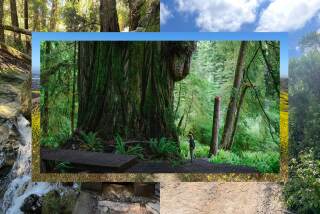Desert Park a Natural for Lancaster
With much fanfare, the city of Lancaster plans today to unveil its latest park, the Prime Desert Woodlands Preserve. It consists of about 65 acres of cracked desert soil and scrub brush, which Lancaster has in abundance.
City officials say they have good reason to be excited about their 10th park, as ordinary as its features may seem. It preserves a patch of the high desert in its natural, pre-development state. The other parks are irrigated oases of imported turf and trees.
“[The preserve] will remain a time capsule of our desert as the Antelope Valley grows and develops,” Lancaster Mayor Frank Roberts said.
Though desert land is Lancaster’s most plentiful resource--about 75% of the area is undeveloped--the population here is expected to grow from about 100,000 to 500,000 in the next 20 years, according to city projections. Officials envision a day when sprawl threatens to gobble up the last expanses of pristine acreage.
Already, along with the junipers, Joshua trees and sand dunes, the preserve’s 2 1/4 miles of trails offer a clear view of the cookie-cutter rooftops of a nearby subdivision. Well within the range of a coyote howl, a Taco Bell serves up Nacho BellGrandes.
The opening of the preserve at 35th Street West and Avenue K-8 marks a hard-won victory for those who have argued that the natural beauty of the desert should remain an integral part of Lancaster’s character.
For the past two decades, developers have lured homeowners to the city with something that might be called the landscaping of denial: The newer subdivisions are carpeted with deep-green lawns and the kinds of flora that were not intended to thrive in the windy Mojave.
“It went from the desert rat philosophy to the Orange County-Mission Viejo philosophy of beautification,” said Lancaster redevelopment administrator Kurt Gunzel. “People appreciated the area for different things back then. With the subdivisions, there was a change in the environment.”
In the late 1970s, a number of residents, chief among them the late Elizabeth “Elyze” Clifford, formed an environmental group that fought to preserve the area’s natural heritage and establish a preserve in the middle of the city. Clifford died in 1990, but the education center at the new park bears her name.
Putting the $3.3-million preserve together was a novel undertaking for the city’s Department of Parks, Recreation and Arts, which until now has created open spaces with green ball fields and non-native shade trees, Parks Director Lyle Norton said.
Norton said it took a while to convince his development-friendly colleagues of the project’s worth.
“The redevelopment director was giving me a hard time, saying, ‘This would make for a good condo project,’ ” Norton said.
But after touring the land, the director changed his tune. “Now all he’s saying is, ‘When are you opening?’ ” said Norton, a Bay Area native who has lived in the Antelope Valley for more than a decade.
Norton, whose reverence for the place grew with time, speaks with a convert’s zeal when he describes what he sees around his property--coyotes, rabbits and the fiery sky at dusk.
“In our daily lives people tend to forget about their own environment,” he said. “When I walk through this place, I get a tremendous sense of beauty.”
More to Read
Sign up for Essential California
The most important California stories and recommendations in your inbox every morning.
You may occasionally receive promotional content from the Los Angeles Times.










